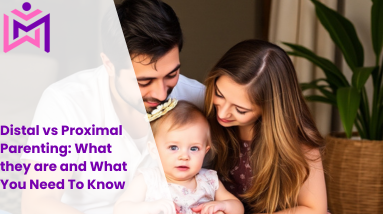Would you know what’s best for your child if culture didn’t influence your parenting style? The truth is, parenting varies greatly worldwide. One of the most important discussions around parenting styles is the idea of distal vs proximal parenting.
These terms may sound technical, but they simply describe two different ways of interacting with and nurturing your child.
In this blog post, we’ll explore distal vs proximal parenting, break down what each style means, and explain why understanding these approaches can help parents raise happy and healthy children.
What Is Distal vs Proximal Parenting?
Let’s start by understanding what distal vs proximal parenting means.
Distal Parenting
Distal parenting is where parents encourage independence and self-reliance in their children. The focus is often on verbal communication, such as talking, explaining and teaching.
Physical closeness, like holding or constant touching, is less emphasized. Instead, the aim is to help the child develop autonomy. It’s common among western cultures.
Examples:
– Encouraging your child to play alone and explore independently.
– Using verbal instructions to guide the child in problem-solving.
– Emphasizing personal achievements, like school performance or extracurricular success.
Proximal Parenting
Proximal parenting, involves a lot of physical closeness. Parents who practise proximal parenting spend a lot of time holding, cuddling, and staying near their children. The focus here is on building a strong emotional bond and making sure the child feels safe and secure through physical contact. Its common among Asian and African cultures.
Examples:
– Carrying your baby in a sling or keeping them close to your body.
– Co-sleeping or having your baby sleep in the same room.
– Responding quickly to a baby’s cries with physical comfort.
Why These Differences Exist
Some experts believe that distal vs proximal parenting evolved based on different environments and needs. In societies where survival and group cooperation were critical, proximal parenting helped keep children safe and close to caregivers. In societies that valued exploration and innovation, distal parenting helped children become more independent.
How Distal vs Proximal Parenting Affects Child Development
Both distal vs proximal parenting can have a big impact on how a child develops, both mentally and emotionally.
Cognitive Development
Distal Parenting and Cognitive Skills: Children are encouraged to think critically and solve problems on their own, which can boost their creativity and intelligence.
Proximal Parenting and Cognitive Growth: They often develop strong emotional intelligence because they are attuned to non-verbal cues, such as facial expressions and touch.
Emotional Development
Distal Parenting and Emotional Independence: Children learn emotional regulation at an early age. This can make them more independent and resilient as they grow. However, they might find it more difficult to express emotions physically, as they are not as used to constant physical closeness.
Proximal Parenting and Emotional Security: Children feel safe and secure, knowing their parents are always nearby. This can lead to high levels of emotional security and empathy for others.
Social Development
Distal Parenting and Social Interaction: Children become mor independent in social situations. They may excel in structured environments like school but might take longer to develop close, intimate relationships.
Proximal Parenting and Social Bonds: Emphasizes close family connections, which can help children become more socially aware and cooperative. They may be more attuned to the needs of others and form stronger group bonds.
Why Distal vs Proximal Parenting Matters
Understanding distal vs proximal parenting is important because both styles influence your child’s development in different ways. Neither approach is superior, what matters most is how well each approach fits with your child’s needs and your family’s values.
Blending Distal and Proximal Parenting
In many modern families, parents are blending elements of both distal vs proximal parenting. For example, you might encourage your child to explore the world independently while also making sure they feel emotionally supported through physical closeness. Finding a balance between these two approaches can help create a well-rounded environment for your child’s growth.
The Long-Term Impact of Parenting Styles
The choice between distal vs proximal parenting can affect your child’s long-term development, from academic success to emotional health. Parents who understand the differences between these approaches can make more informed decisions about how to raise their children, ensuring they meet their unique needs.
Conclusion
Parenting is a journey, and understanding distal vs proximal parenting can help you become more mindful about the choices you make. Both distal and proximal parenting have their advantages, and the key is finding a balance that works for your family.
So, as you continue to raise your child, consider how aspects of distal vs proximal parenting can fit into your family life. After all, the goal is to raise happy, well-adjusted children who are ready to face the world with confidence and compassion.


